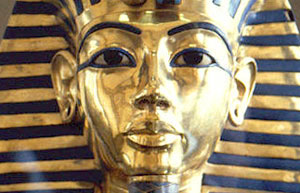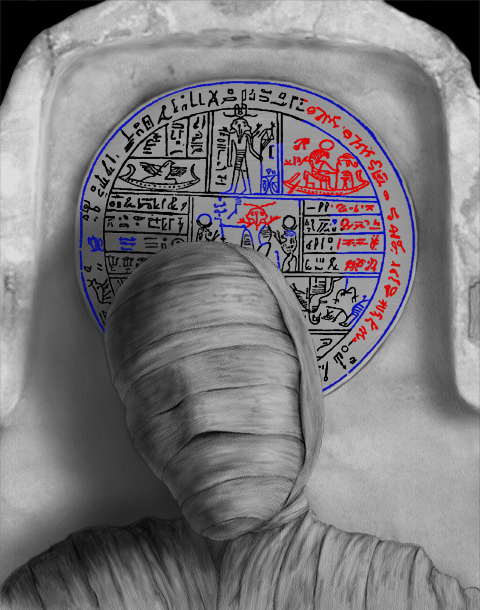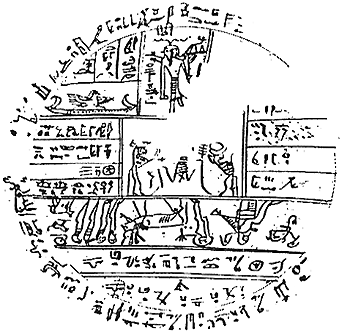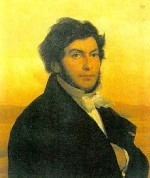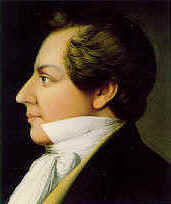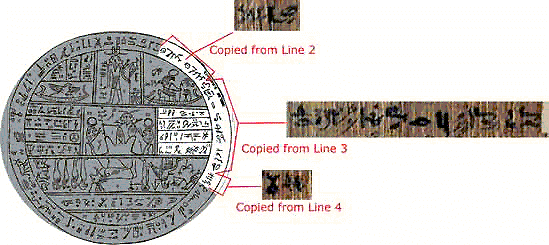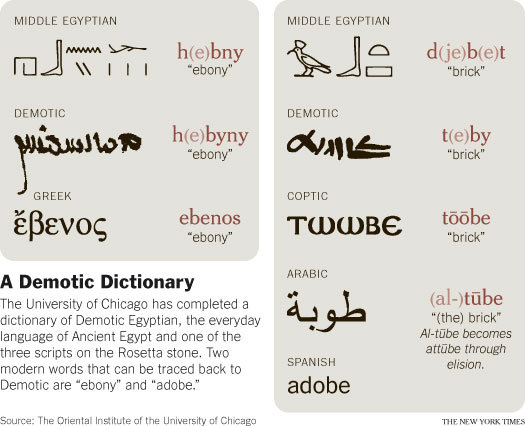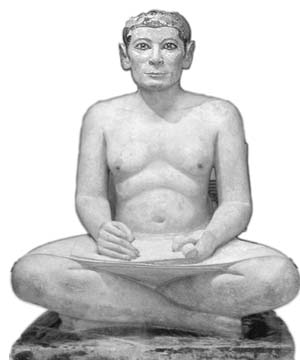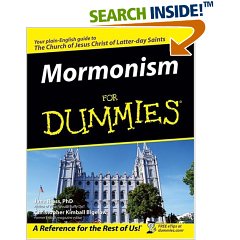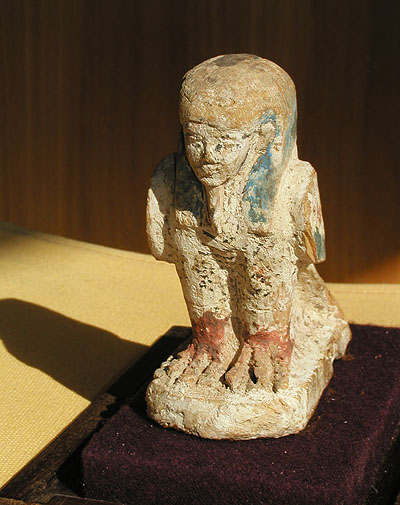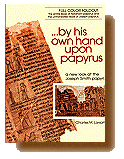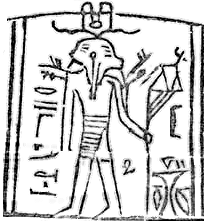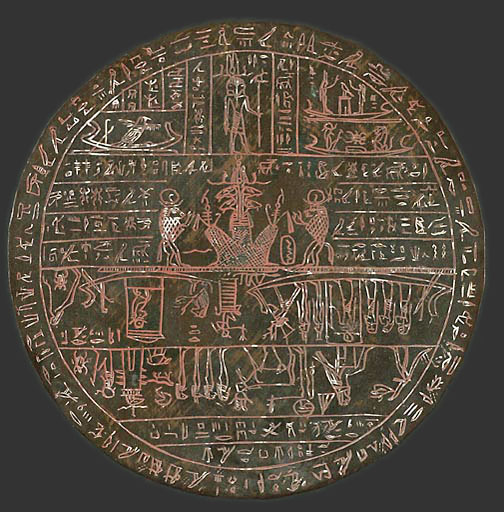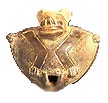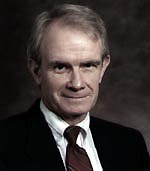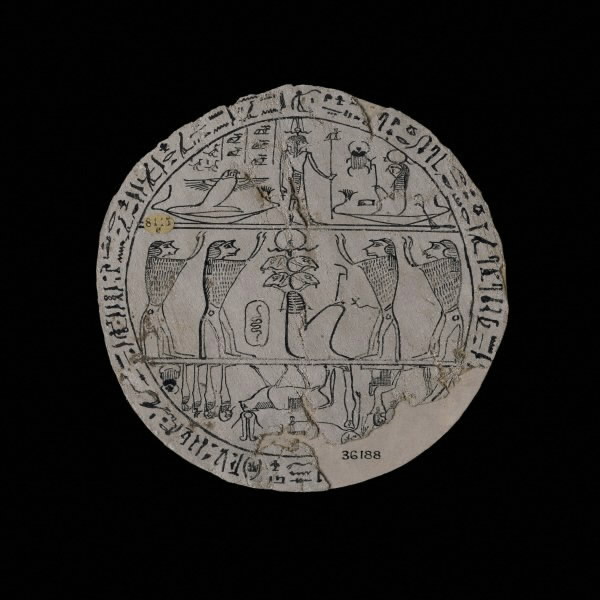Sheshonq’s Hypocephalus
This image depicts the mummy of a person named Sheshonq being laid
to rest with a hypocephalus–a disk covered with prayers,
incantations, and visual representations of various Egyptian gods,
placed behind the head of the deceased to give warmth and divine
power to his or her body in the afterlife. For a member of the LDS
Church, the hypocephalus in this image probably looks very familiar,
because it is based on “Facsimile
No. 2” from The Book of Abraham, found in the LDS scripture
called
The Pearl of Great Price. The
Book of Abraham Facsimiles came from Egyptian papyri that were sold
(along with four mummies) to members of the LDS Church in 1835.
Joseph Smith declared that many of the papyrus documents, including
Facsimile No. 2, were authored by Abraham himself. The Church
believed that the papyri were preserved through the millennia to be
translated by Joseph Smith for the benefit of the restored Church
and the world. The story of the papyri on which The Book of Abraham and Facsimiles are based is a complicated one, and there are many places on the internet (some of which are listed below) where the story is told, from various points of view. The purpose of this image is not to tell that story, rather, its point is very limited–to illustrate a few facts about the history of Facsimile No. 2 that are quite interesting, but are not well known:
Why was Sheshonq’s hypocephalus restored in this fashion by Joseph Smith? People who are skeptical of the claim that Joseph Smith was acting as a prophet of God in preparing Facsimile No. 2 view the blue elements of this image as irresponsible bluffing, and the red elements as cynical lies. A faithful Mormon egyptologist, Michael D. Rhodes, has suggested that the red elements that are comprised of written characters, found on the edge and right-hand block of Facsimile No. 2, were copied there “for aesthetic purposes.”
|
| |||||||||||||||
Figure a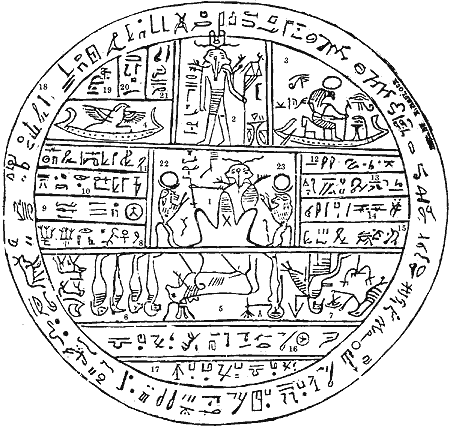 If you will remember, Joseph received four mummies. From these four mummies, he received five different texts.1 The three which are applicable to our current study are:
The latter document (3) was a "hypocephalus" shown above, called such because it was placed under the head of the deceased (literally hypo - under, cephalus - head) in order to magically keep the head warm and preserved.2 Facsimile #2 is this hypocephalus for Sheshonk. Joseph Smith, simply took Sheshonk's hypocephalus, combined it with the two vignettes from Hôr's Breathing Permit, and included the documents in his Book of Abraham. Translating and interpreting the hypocephalus is a little harder than Hôr's vignettes, due to a combination of poor copying by Reuben Hedlock, and incorrect restorations from damaged areas in the original document. An early rendering — perhaps the first — of this hypocephalus is included below. Note the clear indication of a swath of missing papyrus extending from the center to the northeast section of the drawing, Fig. a'.
The vignettes in the damaged sections were probably "restored" in the same manner that Anubis was "restored" in Hôr's first vignette. And, the writing around the edge and in the square section just to the right of the middle (pictured below), was "restored" by copying symbols from Hôr's Breathing Permit and placing them into the "restoration". We know they are symbols from Hôr's Breathing Permit because they are hieratic as opposed to hieroglyphic (which composes the rest of the writing on this hypocephalus), and we can tell which lines in the Joseph Smith Papyri the hieratic writing came from.
A Note About Hypocephali in general Before we delve into the interpretation and translation of the hypocephalus known as Facsimile 2, let's take a moment to familiarize ourselves with hypocephali in general. While Joseph Smith apparently thought of this hypocephalus as a study of cosmic concepts, Egyptians would have thought of it as a funerary document which contained imagery and text culled from their long-standing religious beliefs, which would aid the deceased along their journey toward the afterlife. Even the shape of the hypocephalus was significant in this context.
The writing and vignettes inside the circle which make up the hypocephalus is about transformation. Transformation is the key word in the Egyptian concept of our journey into the afterlife. The deceased transforms into a spiritual being, or is re-born as one. To symbolize this, the ancient Egyptians used the most apparent phenomenon of nature they knew — the sun and its daily rebirth. Fertility imagery is also used, often paralleled with animals such as bulls, rams, etc. As for the specific content inside our hypocephalus, commonly known as Facsimile 2, here is a short summary (we'll greatly expand on this in the next section): We start with the writing at the very bottom, which asks that the deceased's tomb not be desecrated and that his/her soul may also not be desecrated in the Netherworld. Next, we proceed to the figures at the bottom (drawn upside down) which represent the deceased's re-birth, or transformation, into the afterlife and divine realm. Again, symbolizing the process of re-birth/transformation is the fertility god Min, followed by the goddess Hathor who is there to greet the deceased. We then proceed to the middle level, in which the condition of the afterlife is depicted, along with an invocation requesting that the deceased may be granted eternal life (see the text to the left of the vignette). Finally, we end at the top level which symbolizes the deceased gaining eternal life. In addition to the drawings, we have writing which was from the Book of the Dead (chapter 162)3, and which was customized to each deceased person with whom it was buried (in this case, a person named Sheshonk). In Facsimile 2, the writing was originally hieroglyphic (the earlier form of ancient Egyptian writing), but many of the missing sections was filled in with hieratic symbols (which was a later form of Egyptian writing). Hypocephali first appeared around 663-525 B.C.E.4, which is, of course, much too late for Abraham, who would have lived somewhere between 2200 B.C.E. and 1500 B.C.E. at the very latest. Facsimile 2 — Number by NumberOne of the problems with discussing Facsimile 2 is that we don't have the original. We have an inaccurately "restored" drawing of the original. Therefore, in an effort to help us visualize what the original figures would probably have actually looked like, let's introduce a very similar hypocephalus from the British Museum: | |||||||||||||||
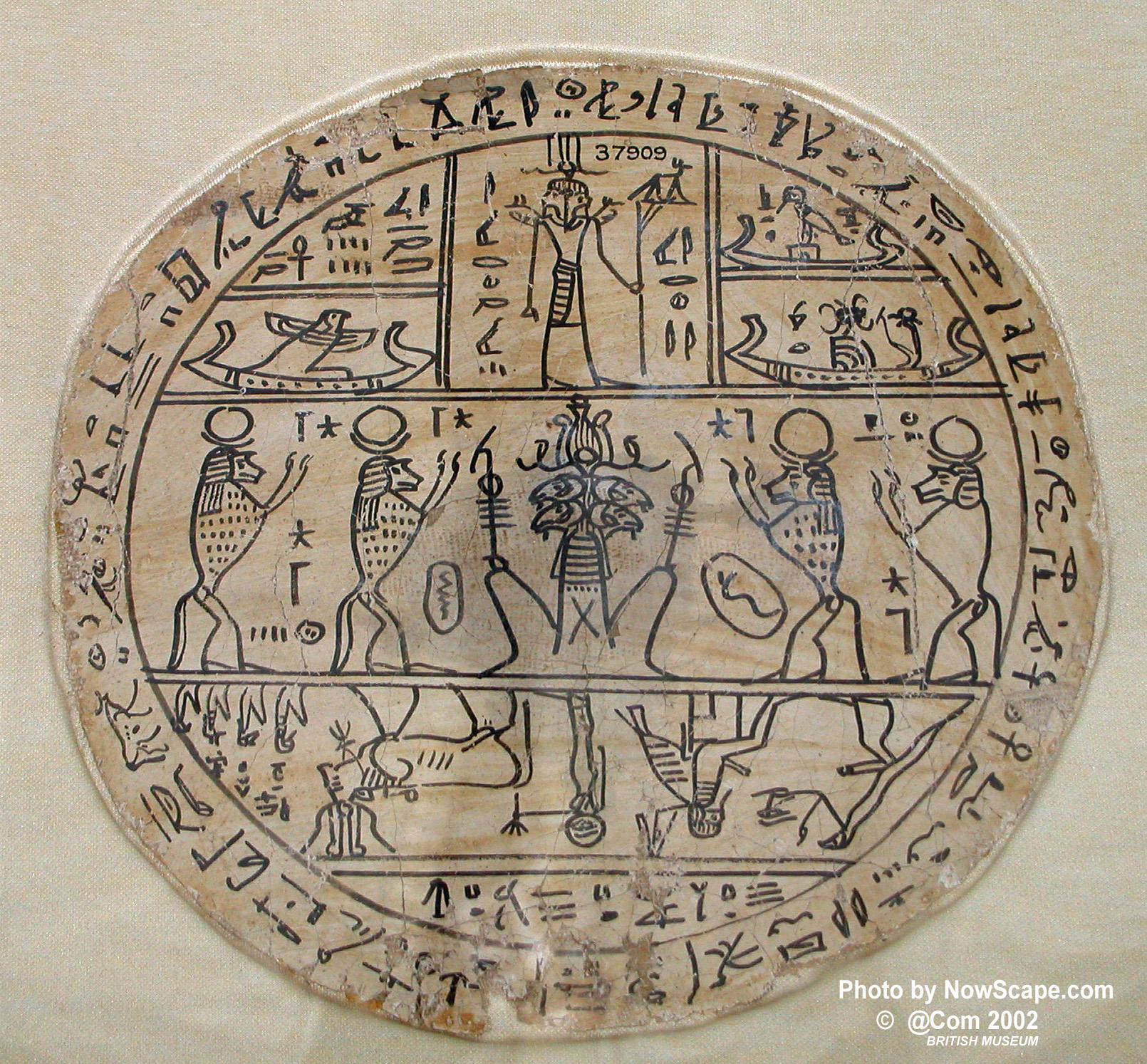 Sheshonq’s Hypocephalus Click to Enlarge | |||||||||||||||
|
As we move through the small numbered segments on
Jos. Smith's, Facsimile #2 (Figure a) we'll compare its figures with those of
Sheshonq’s Hypocephalus shown above. | |||||||||||||||
| |||||||||||||||
|
Figure 1
Joseph Smith said that Figure 1 was: "Kolob, signifying the first creation, nearest to the celestial, or the residence of God. First in government, the last pertaining to the measurement of time. The measurement according to celestial time, which celestial time signifies one day to a cubit. One day in Kolob is equal to a thousand years according to the measurement of this earth, which is called by the Egyptians Jah-oh-eh." Link - Mormon Liturgy: ♫ If You Could Hie to Kolob Notice the differences between Figure 1 in Facsimile 2 on the left and the same figure in the British Museum hypocephalus on the right. Also, remember that this figure was one of the casualties of the damaged section in the original hypocephalus (see the picture of Figure b above on this page). There has been a little controversy in the past among some Church defenders and Egyptologists as to whether this figure should have four ram-heads, or whether it's possible for it to have only two. While two ram-heads aren't unheard of, in this context the figure should properly have four heads as depicted in the figure on the right. Regarding figure 1, Dr. Samuel A. B. Mercer, Ph.D. said, "It represents the four-headed ram-god, a form of Khnumu in whom, as Weigall in Petrie, Abydos I says, the spirits of the four elements were said to be united.5
Figure 2 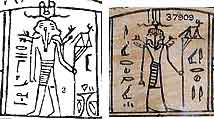 Joseph Smith said this figure: "Stands next to Kolob, called by the Egyptians Oliblish, which is the next grand governing creation near to the celestial or the place where God resides; holding the key of power also, pertaining to other planets; as revealed from God to Abraham, as he offered sacrifice upon an alter, which he had built unto the Lord."
Dr. Mercer said that Figure 2, "Represents a god with two faces — the double aspect of the sun in setting and rising."9 This figure wears the headdress of Amun, and is identified as Amun-Re by BYU scholar Michael D. Rhodes.10 The depiction of the sun setting and rising was very important to the Egyptians in this context as it symbolized rebirth/transformation into the spiritual realm after death takes place. Remember, also, that this figure was part of the top level of the hypocephalus, in which the deceased had achieved his/her goal of eternal life. By the way, "Oliblish" is not a known Egyptian word. Figure 3  Figure 3 is actually in the damaged section of the original hypocephalus. As you can see from the three images above, the same section of the British Museum hyocephalus (far right and Figure b, above) is very different than the one in Facsimile 2 (far left), but notice the similarity between the picture in the middle with Figure 3 on the left. Interestingly, the picture in the middle is a segment of the papyrus identified as the proposed "Book of Joseph". Perhaps there was enough of the original hypocephalus for Joseph to make out the ends of a bark (boat) — notice that the British Museum hypocephalus on the right has a bark in the same exact place. Perhaps Joseph deduced that there was supposed to be a figure in a bark in the damaged section, and, wishing to be as authentic as he could and noticing that there was another figure in a similarly shaped bark in the Book of Joseph papyrus, he had Rueben Hedlock copy the Book of Joseph figure onto the hypocephalus where the damage was.
Of course, this is all conjecture. Who knows why he used the figure he did in his "restoration". For whatever reason it's there, here is what Joseph said it was: "Is made to represent God, sitting upon his throne, clothed with power and authority; with a crown of eternal light upon his head; representing also the grand Key-words of the Holy Priesthood, as revealed to Adam in the Garden of Eden, as also to Seth, Noah, Melchizedek, Abraham, and all to whom the Priesthood was revealed." Dr. Samuel Mercer identified the figure as: "Horus-Re sitting in his boat with the user, the royal sceptre which gave dominion over heaven and earth, in his hand. There is with him two uzat-eyes. These were used as amulets for protection against the evil eye. He is crowned with the sun's disk and ruaeus. An offering table stands before him."11 It would be interesting to go back in time and see if Joseph Smith's hypocephalus originally had the same figures as this British Museum's hypocephalus or not.11a They are alike in so many other ways. So, even though it's secondary to our discussion on Facsimile 2, here is the interpretation of the two figures on the far right picture above. The deity in the upper corner is the Bennu, who sometimes was pictured as the bird and other times as a man with a Bennu's head. The Bennu is a symbol of being united with Ra, since it is "the soul of Ra". And, the Khepri (below the Bennu) ends the story of the transformation of the deceased told within the hypocephalus by depicting the deceased as the rising sun, in other words, the deceased is reborn and symbolised as being one with the rising sun. Figure 4  Joseph Smith said this figure: "Answers to the Hebrew word Raukeeyang, signifying expanse, or the firmament of the heavens; also a numerical figure, in Egyptian signifying one thousand; answering to the measuring of the time of Oliblish, which is equal with Kolob in its revolution and in its measuring of time." This figure doesn't seem to be very common, but is interesting. Dr. Mercer said that it represents Sokar,12 probably based on the fact that this is a Hawk, and Sokar is often represented as a hawk. But this figure has some interesting features that's not common. The outstretched wings indicates the realm of the spirit or afterlife, and since the lower-half of the figure is mummified, it seems as though this represents the deceased — in other words, the union of the deceased with the spiritual realm; the birth of the Horus in the afterworld. Figure 5  Joseph said that this figure: "Is called in Egyptian Enish-go-on-dosh; this is one of the governing planets also, and is said by the Egyptians to be the Sun, and to borrow its light from Kolob through the medium of Kae-e-vanrash, which is the grand Key, or, in other words, the governing power, which governs fifteen other fixed planets or stars, as also Floeese or the Moon, the Earth and the Sun in their annual revolutions. This planet receives its power through the medium of Kli-flos-is-es, or Hah-ko-kau-beam, the stars represented by numbers 22 and 23, receiving light from the revolutions of Kolob." Dr. Mercer said figure 5, "represents the cow of Hathor, behind which stands a uzat-headed goddess holding a sacred tree." He also noted that there is no such Egyptian word as "Enish-go-on-dosh".13 Kae-e-vanrash, Floeese, Hah-ko-kau-beam and Kli-flos-is-es are Hebrew transliterations that were undoubtedly the result of Joseph's study of Hebrew from Prof. Seixas. In the funerary context, Hathor is welcoming the deceased. Figure 6  Joseph said this figure: "Represents this earth in its four quarters." These are the very well known entities of the four Sons of Horus. Defenders of Joseph Smith's interpretations are fond of calling this a "direct hit" for Joseph, in that the Sons of Horus are associated with the four cardinal points of the earth, North (Hapy), South (Imsety), East (Duamutef), and West (Qebehsenuef). However, calling this a "direct hit" is a stretch, in my opinion. The four Sons of Horus are associated with the cardinal points in only one aspect, and never in a funerary context such as this one.13a In a funerary context, the Sons of Horus were seen as protectors of the deceased's internal organs. Imsety protected the liver, Hapy protected the lungs, Duamutef protected the stomach, and Qebehsenuef protected the intestines. Figure 7 
Jos. Smith said that figure 7, "Represents God sitting upon his throne, revealing through the heavens the grand Key-words of the Priesthood; as also, the sign of the Holy Ghost unto Abraham, in the form of a dove." This figure is clearly the ithyphallic god Min. Next to Min, shown more clearly (in the British Museum hypocephalus on the right above - also seen in Hypocephalus of Irethorrou, right, for example), is the ithyphallic snake which represents Atum, whose power of creation was often represented in the form of a snake. The ithlyphallic pose underlines this creative aspect. I suspect that the unfinished representation of Atum in Facsimile 2 (due probably to damage in the original) was interpreted by Joseph to be a figure "in the form of a dove", rather than that of a snake. Overall, this entire lower register describes the deceased's entry into the divine realm of the afterlife and the beginning of his/her transformation — his/her re-birth to that realm, as represented by these ithyphallic figures. Figure 8-11 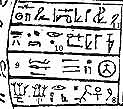 Joseph gave the following translations of this writing:
Joseph Smith seems to have numbered these backwards. The writing is actually read from top to bottom, or, in other words, from Figure 11 down to Figure 8. According to Michael D. Rhodes, BYU, figures 11-8 actually read:14
Figures 12-21 Joseph didn't offer any other translation, other than to write the following: "Figures 12, 13, 14, 15, 16, 17, 18, 19, 20, and 21 will be given in the own due time of the Lord." Apparently that time has now come, as we can translate these figures today. 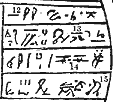 Figures 12-15 were apparently damaged in the original, and were "restored" by pasting in hieratic symbols for Hôr's Breathing Permit — upside-down. A trace of the original hieroglyphic writing can be made out, but only the phrase "his words" can be made out at the end of the line in Fig. 15. The remainder of these lines are filled with hieratic writing taken from lines 4 and 5 of Hôr's Breathing Permit15:
  Figures 16 and 17 should actually be read in the following order:
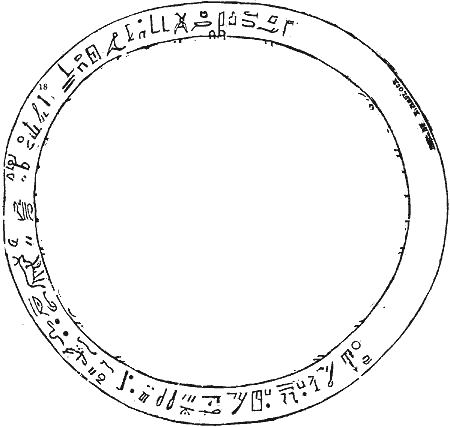 Three-fourths of the original hieroglyphic inscription appears to have survived, and counterclockwise reads:17


1. The other two fragments were (1) The Book of the Dead belonging to the female musician Amon-Re Neferirnûb; and (2) Book of the Dead belonging to Amenhotep. See H. Michael Marquardt, The Book of Abraham Papyrus Found, 2nd edition 1981, publ. by Utah Lighthouse Ministry, p. 23, 24; and Klaus Baer, "The Breathing Permit of Hor", Dialogue: A Journal of Mormon Thought, Autumn 1968, p. 111 - Back to article 2. See this short description of hypocephali by the British Museum -
Back
14. Michael D. Rhodes, Brigham Young University Studies, Spring 1977, p. 265 -
Back | |||||||||||||||

